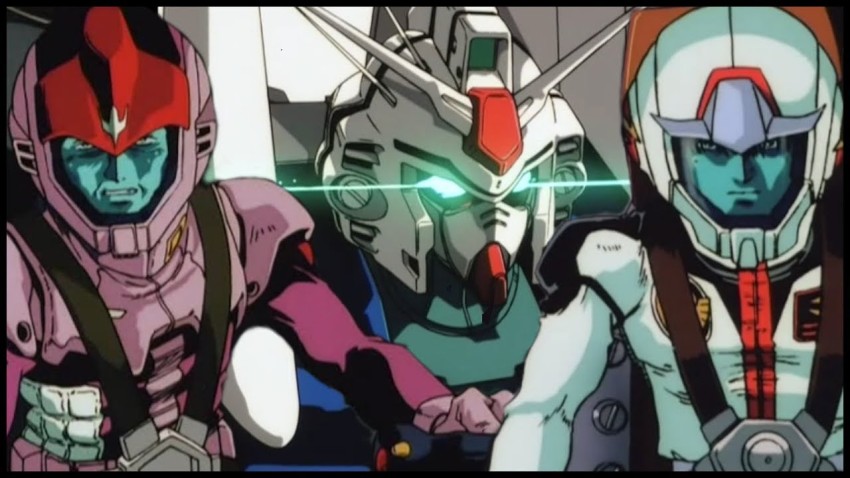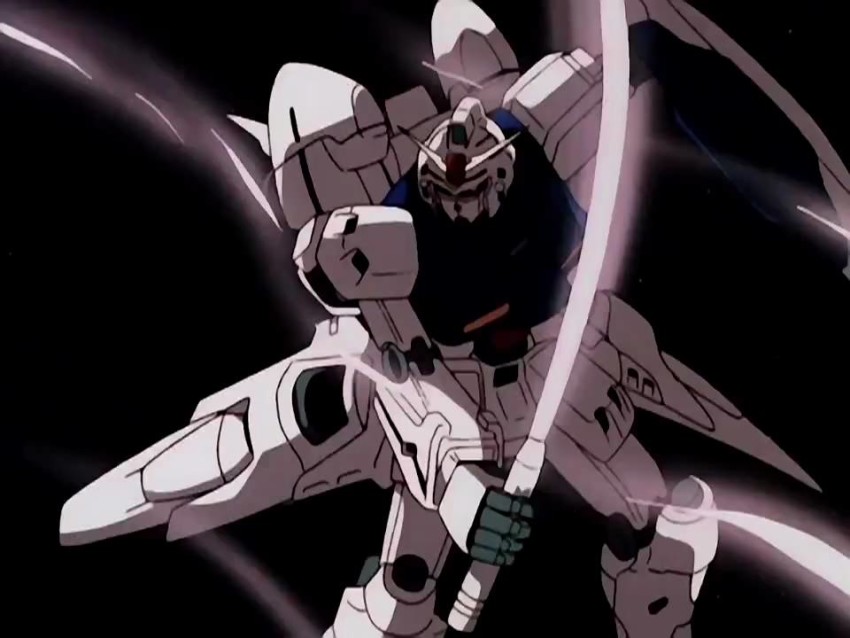Gundam 0083: Stardust Memory
May 30, 2021 · 0 comments
By Andrew Osmond.
 Gundam 0083: Stardust Memory is a terrific “untold chapter” in the Gundam franchise, and an excellent way into Gundam for newbies. Stardust Memory is essentially one story, told over 13 half-hour episodes, with all-new characters, a compelling arc and production values which still look impressive today. Many of the other Gundam series run to around 50 parts each; anime fans who’ve grown up with today’s compact TV anime may find Stardust Memory more digestible. The series assumes you know a minimal amount of Gundam’s backstory, but we’ll fill you in on that in the next two paragraphs.
Gundam 0083: Stardust Memory is a terrific “untold chapter” in the Gundam franchise, and an excellent way into Gundam for newbies. Stardust Memory is essentially one story, told over 13 half-hour episodes, with all-new characters, a compelling arc and production values which still look impressive today. Many of the other Gundam series run to around 50 parts each; anime fans who’ve grown up with today’s compact TV anime may find Stardust Memory more digestible. The series assumes you know a minimal amount of Gundam’s backstory, but we’ll fill you in on that in the next two paragraphs.
Most of that backstory was told in the opening spiel of the first Gundam TV series from 1979. “It is the year 0079 of the Universal Century. Fifty years have passed since Earth began moving its population into gigantic orbiting space colonies… The cluster of colonies furthest from the Earth proclaimed itself the Principality of Zeon and launched a war of independence against the Earth Federation. Initial fighting lasted over one month and saw both sides lose half their respective populations. People were horrified by the indescribable atrocities committed in the name of independence…”
Officially, the war lasted a year (it’s referred to as the One Year War) and ended with Zeon’s defeat. As Gundam fans know, the real conflict ground on for far longer. As its titular dateline indicates, Stardust Memory starts four years after the war, as two upgraded Gundams – giant combat machines piloted by human soldiers – are delivered to an army base in Australia. The carrier craft delivering them is the good ship Albion, and on board is the new Gundams’ designer, Nina Purpleton. It’s her first time on Earth, having been born and raised on a lunar colony. Earth may have won the One Year War, but it left the planet scarred. Passing over ocean, the Albion’s captain tells Nina they’re over what was once Sydney; the Zeons sent a space colony crashing to Earth, with cataclysmic results.
 Arriving at the army base, Nina encounters a cute young test pilot called Kou Uraki, who seems barely more than a boy. He annoys her with his obsessive fascination with the Gundams, but there are other eyes on the big robots. That night, there’s a dramatic heist (the show calls it a “Gundamjack”) carried out by Zeon infiltrators, led by the dashingly honourable, decidedly manly Commander Gato. Gato steals one of the Gundam units; Uraki, who happens to be taking another peek at the robots, rushes to board the other. So Gato and Uraki have the first of many confrontations in the series.
Arriving at the army base, Nina encounters a cute young test pilot called Kou Uraki, who seems barely more than a boy. He annoys her with his obsessive fascination with the Gundams, but there are other eyes on the big robots. That night, there’s a dramatic heist (the show calls it a “Gundamjack”) carried out by Zeon infiltrators, led by the dashingly honourable, decidedly manly Commander Gato. Gato steals one of the Gundam units; Uraki, who happens to be taking another peek at the robots, rushes to board the other. So Gato and Uraki have the first of many confrontations in the series.
Of course, Uraki is painfully outmatched in their first meeting, and ends up beaten and shamed; Gato treats his foe with crushing contempt. Uraki’s part in the action seems over, as Gato escapes with the stolen Gundam… though now Nina seems more intrigued by Uraki and his evident skills. The rest of the series centres on Nina, Uraki and Gato, blending adventure with awkward romance (Uraki, of course, is the immature naif). To his own amazement, Uraki finds himself travelling to space as a key player in a conflict between Earth and Zeon that will reshape history.
You may find some sources claiming that Stardust Memory’s chief combatants, Uraki and Gato, are simple copies of the “star” characters of the earlier Gundam series, Amuro Ray and Char Aznable. But Stardust Memory is much more cunning than that. Certainly Uraki and Gato are set up in the first episodes to remind viewers of Amuro and Char; they even look broadly similar. But as the story goes on, the differences between the characters grow obvious; for example, Gato operates by a quite different code from Char. For his part, Uraki is given the kind of romantic storyline that Amuro never enjoyed (Amuro was fixated on a ghostly fantasy girl, far from the flesh-and-blood Nina!)
Indeed, the relationship between the barely-adult Uraki and the womanly Nina offers a foreshadow of Makoto Shinkai’s Garden of Words. Nina has experience of relationships which Uraki lacks, and this colours their own relationship through the series. It also offers thematic justification for a story revelation later on, which was reportedly controversial with fans. Perhaps the story points don’t add up satisfyingly, but thematically they heighten the sense of Uraki grappling with an adult world which he doesn’t fully understand till the last minutes.
As is often the case in Gundam, there are odiously Neanderthal male attitudes to women on display – indeed, one pilot character seems to be nothing but such gross attitudes. Yet Nina and her big-built friend Mora are never infantilised like the women in trad American space opera (see old Star Trek). The way that the women are nonchalantly empowered is just as typical of old-school Gundam. Compared to some Gundam series, Stardust Memory is told mostly from one “side” – the perspective of Uraki and the Federation – but some of the most powerful moments come precisely when the show presents another point of view. The last episode, especially, sets out to scramble our sympathies.
 Released in 1991-2, Stardust Memory was made for video, which may account for its production values being well above par for the TV Gundams of the time. The humans and mecha look physically dimensional, like those in the recent Akira. The characters are glamorously attractive, especially the impressively-coiffed Nina who recalls the Kelly McGillis character in Top Gun, in appearance if not personality. Some fans play up the similarities between Stardust Memory and Top Gun; they do add a gloss, but they’re not what make the anime interesting. The character designs were by Toshihiro Kawamoto, who’d cut his teeth as an inbetweener on the original Gundam in 1979. He’d later be the character designer on Cowboy Bebop.
Released in 1991-2, Stardust Memory was made for video, which may account for its production values being well above par for the TV Gundams of the time. The humans and mecha look physically dimensional, like those in the recent Akira. The characters are glamorously attractive, especially the impressively-coiffed Nina who recalls the Kelly McGillis character in Top Gun, in appearance if not personality. Some fans play up the similarities between Stardust Memory and Top Gun; they do add a gloss, but they’re not what make the anime interesting. The character designs were by Toshihiro Kawamoto, who’d cut his teeth as an inbetweener on the original Gundam in 1979. He’d later be the character designer on Cowboy Bebop.
Moreover, the storyboard and unit director team included Bebop’s future creator-director, Shinichiro Watanabe himself. This was back when Watanabe was working his way up through the industry; he’d previously directed episodes of Armor Hunter Mellowlink, a hard-core military-mecha video spun off from the better-known Votoms. Stardust Memory’s mechanical designs are credited to multiple artists, including Hajime Katoki who’d become a mainstay of the Gundam franchise, but there’s also a separate “Mechanical Styling” credit for Shoji Kawamori. Yes, that Kawamori, famed co-creator of the rival Macross franchise, crossing over to help the enemy.
As many anime fans know, Kawamori and Watanabe would unite a couple of years after Stardust Memory, when they would co-direct Macross Plus. That would also be another glossy made-for-video update of an old “mecha” franchise, telling a compact story accessible to new viewers, with Top Gun vibes and a romantic centre. Incidentally, one of Watanabe’s fellow storyboarders on Stardust Memory was Kazuki Akane, who would later rework a Kawamori concept into a beloved fantasy with giant robots, Vision of Escaflowne. Akane would later direct Noein and, more recently, the baseball anime drama Stars Align.
Of Stardust Memory’s characters, Ko was voiced in Japanese by Ryo Hirakawa, no stranger to epic space opera anime made for video. Hirakawa had played Reinhard in the epic Legend of the Galactic Heroes from 1988, though most fans will know him as Vegeta in the Dragon Ball franchise. Nina’s actor Rei Sakuma also had form in space opera, having played Kazumi (the “big sister” character) in Gunbuster. She was also everyone’s favourite witch’s cat Jiji in Kiki’s Delivery Service and Shampoo in Ranma, though most Japanese kids will know her as Batakao-san in Anpanman. As for Gato, he was voiced by Akio Otsuka in one of his early anime roles; fans might have recognised him as Captain Nemo in Gainax’s Nadia: The Secret of the Blue Water. A few years after Stardust Memory, Otsuka would voice the hulking cyborg Batou in the first Ghost in the Shell film, a role he’d reprise many times.
Within Gundam’s franchise history, Stardust Memory was made during a transition. It was one of the Gundams made in the aftermath of the 1988 film Char’s Counterattack, which had retired the franchise’s “star” characters (including Amuro and Char) and left Gundam to find new directions. While different titles tried a range of courses – including, eventually, the all-out reboot of 1995’s Gundam Wing – Stardust Memory found a particularly good niche.
The whole Gundam franchise had started off with the original 1979 TV series. The next series, Zeta Gundam in 1985, had continued the story. However, Zeta Gundam was set eight years after its predecessor (in the year 0087), depicting an Earth that had changed greatly in the interim. Taking advantage of this, Stardust Memory was placed in the gap between the series, and its ending explains why Earth has changed so drastically by Zeta Gundam. Consequently, Stardust Memory doesn’t feel like a side-story, but rather a restored chapter of the larger Gundam story.
Andrew Osmond is the author of 100 Animated Feature Films. Gundam 0083: Stardust Memory will be released in the UK by Anime Limited.
Leave a Reply